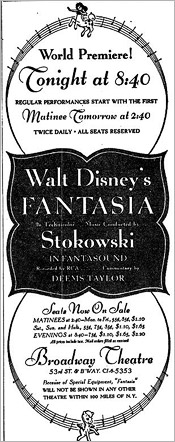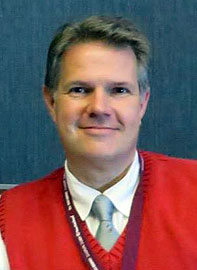“Fantasia went so far beyond the standards of the day that it was well and truly ‘ahead of its time,’ and ‘one of a kind.’” — Disney Historian Jeff Kurtti
The Digital Bits is pleased to present this retrospective commemorating the diamond anniversary of the release of Fantasia, Walt Disney’s innovative and acclaimed third feature-length animated production (after Snow White and the Seven Dwarfs and Pinocchio) featuring Leopold Stokowski conducting the Philadelphia Orchestra over the memorable fusion of image and music. [Read on here...]
Though not too popular with audiences on initial release, the film was a hit with critics. The New York Times, notoriously elitist when it comes to reviewing motion pictures, loved it, proclaiming motion picture history had been made. “Nothing ever existed like Fantasia… to describe it is impossible… you must see it,” raved Esquire Magazine. Redbook boasted, “Adjectives, even the most extravagant sort, seem inept when applied to Fantasia… one of the screen’s greatest accomplishments.” Look Magazine called it “the most daring and revolutionary motion picture since 1927.” And many critics singled out the film’s revolutionary audio, the Buffalo Evening News, for instance writing, “The element of Fantasia upon which all doubtless will agree is that third-dimensional quality of the sound reproduction. No one with hearing could miss the air-pulsing reality of the ear’s new delight.”
The Bits celebrates the 75th anniversary of Fantasia with a film historian Q&A and a listing of the film’s original roadshow engagements.
THE ROADSHOW ENGAGEMENTS
Presented here is a chronological listing of Fantasia’s “hard ticket” roadshow engagements in the United States and Canada. These were special showcase presentations exhibited prior to the film being given a general release, and they featured advanced admission pricing, reserved seating, an intermission, two scheduled screenings per day, and a souvenir program booklet.
Out of hundreds of films released during 1940, Fantasia was among only a few that were given roadshow exhibition. The duration of these engagements, measured in weeks, has been included to give a sense of how successful the film was in its first phase of release. Some of these were presented in special multi-channel audio which Disney aptly named Fantasound.
Five months into the release, RKO Radio Pictures took over distribution from Disney. Consequently, several of the planned roadshow bookings were cancelled and the Fantasound audio component was eliminated from the presentations. Moreover, for the general release in 1942, the film was reduced in running time by several minutes. The film has been re-released countless times since (and perhaps holds the record for the film released in the most number of different projection and sound formats).
- 19
 40-11-13 … New York, NY — Broadway (49 weeks) Fantasound
40-11-13 … New York, NY — Broadway (49 weeks) Fantasound
- 1941-01-28 … Boston, MA — Majestic (15) Fantasound
- 1941-01-29 … Los Angeles, CA — Carthay Circle (39) Fantasound
- 1941-02-12 … Philadelphia, PA — Aldine (12) Fantasound
- 1941-02-18 … Detroit, MI — Wilson (11) Fantasound
- 1941-02-19 … Chicago, IL — Apollo (15) Fantasound
- 1941-03-05 … Pittsburgh, PA — Fulton (8) Fantasound
- 1941-03-05 … San Francisco, CA — Geary (12) Fantasound
- 1941-03-18 … Cleveland, OH — Hanna (9) Fantasound
- 1941-04-12 … Buffalo, NY — Erlanger (4) Fantasound
- 1941-04-12 … Minneapolis, MN — Minnesota (5)
- 1941-05-12 … Washington, DC — National (7)
- 1941-05-15 … Baltimore, MD — Maryland (5)
- 1941-05-15 … Hartford, CT — Regal (2)
- 1941-05-15 … Louisville, KY — Strand (1)
- 1941-05-22 … Memphis, TN — State (1)
- 1941-05-23 … Cincinnati, OH — Shubert (1)
- 1941-05-28 … Madison, WI — Parkway (1)
- 1941-05-28 … Richmond, VA — Capitol (2)
- 1941-05-28 … Seattle, WA — Blue Mouse (1)
- 1941-05-29 … Portland, OR — Music Box (1) Fantasound
- 1941-06-02 … Montreal, QC — His Majesty’s (2)
- 1941-06-05 … Portland, ME — Empire (1)
- 1941-07-22 … Denver, CO — Aladdin (3)
- 1941-09-29 … Toronto, ON — Royal Alexandra (3)
THE INTERVIEW
 This segment of the article features a Q&A with Jeff Kurtti, film historian, author, producer and Disney authority.
This segment of the article features a Q&A with Jeff Kurtti, film historian, author, producer and Disney authority.
Jeff Kurtti is one of the leading authorities on The Walt Disney Company and its history. The author of more than 25 books, including Disneyland Through The Decades (Disney Editions, 2010), Kurtti worked for Walt Disney Imagineering, the theme park design division of The Walt Disney Company, and then for the Corporate Special Projects department of Disney. More recently he was creative director, content consultant, and media producer for The Walt Disney Family Museum. While with Kurtti-Pellerin Productions and TV is OK Productions, Jeff was involved with the creation of value-added content for numerous home-video releases (including material for Fantasia and other Disney titles). He was also a producer on the feature documentary The Boys: The Sherman Brothers’ Story (2009).
Michael Coate (The Digital Bits): In what way is Fantasia worthy of celebration on its 75th anniversary?
Jeff Kurtti: It represents a kind of finale ultimo moment in the earliest age of the art and culture of animation—and that is always worthy of revisitation, context, and celebration.
Fantasia debuted at the Broadway Theatre in New York City on November 13, 1940. It’s really remarkable to remember that under its previous name, the Colony Theatre, the same venue had hosted the screen debut of Mickey Mouse just 12 years earlier.
That leap in the medium of animation in that short span of time represents a creative and technical progression that is stunning.
It is the work of a collective of designers, artists, technicians, and musical talents at the pinnacle of their skills and creativity, in an unprecedented environment of freedom.
Ollie Johnston recalled, “We had a staff there that I know that Walt felt was the finest that could be assembled and that he could do anything with those people and that he had the money to do anything he wanted, and this was a rare position to be in, to have those two things.”
“Fantasia, to me, is a whole new opportunity,” Walt said. “It was just a desire to explore the possibility to open up new avenues for the medium so that we would have a chance for full expression.”
Coate: What are the standout segments in Fantasia?
Kurtti: I feel that although it stops short of its Fischinger inspiration, Toccata and Fugue in D Minor sets a tone for what the whole experience aspires to be. The Sorcerer’s Apprentice is a kind of perfection. Night on Bald Mountain is an epic and majestic thing.
Coate: Can you recall your reaction to the first time you saw Fantasia?
Kurtti: When I was a kid in Seattle in the pre-cable, pre-video era, Fantasia was an “unattainable”—as were many Hollywood classics. I saw clips occasionally on the Disney TV program, and stills in books and magazines, but it wasn’t until a New Year’s Eve midnight screening when I was in Junior High or High School that I actually got to see the full feature.
The theatre manager was baffled by why his theatre was almost sold out on a New Year’s Eve at midnight, but none of us who had gathered there were. We felt this may be our only chance to actually see this feature—and we weren’t going to miss it.
We were not disappointed.




